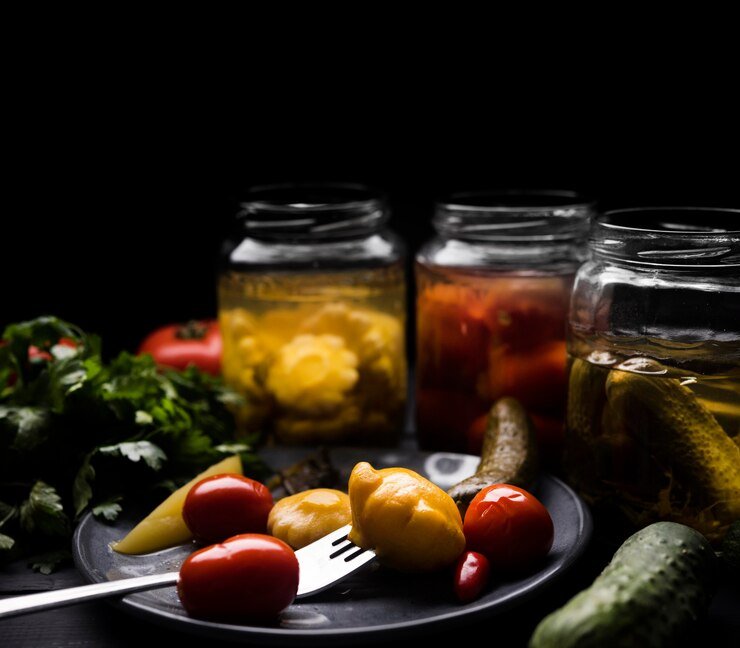Sparks and Bubbles: Where Fire Meets Fermentation
Imagine sitting by a medieval hearth. A pot simmers slowly over open flames while, nearby, clay jars filled with bubbling grains release a sour, yeasty aroma. Both the crackle of fire and the quiet fizz of fermenting food tell the same story our ancestors learning how to transform raw ingredients into nourishment.
The history of fermentation food is as old as open fire cooking itself. Fire gave humans heat, flavor, and safety from raw meat. Fermentation gave them preservation, nutrition, and variety. Together, these two methods became the backbone of traditional cooking across cultures. Surprisingly, many of the tools and techniques developed centuries ago still exist in some form today.
Why This History Matters
Looking at open fire cooking and fermentation together tells us something important: our survival and culture depended on ingenuity. Fire alone could cook food, but fermentation gave it life beyond the moment. It turned grains into beer, milk into cheese, and cabbage into sauerkraut. These weren’t just meals—they were methods of survival in harsh climates and long winters.
Even today, both methods remain symbols of authenticity. A loaf of sourdough baked in a wood-fired oven or a piece of fire-roasted meat feels more connected to the past than its microwave-heated counterpart.
The History of Fermented Food
Archaeologists trace fermentation back over 9,000 years, with evidence of rice and honey wine discovered in China. Egyptians perfected beer and bread through wild yeast. Greeks and Romans fermented olives and fish sauce. In Korea, kimchi became more than food; it was medicine, culture, and ritual.
Fermentation was never just about taste. It had practical benefits:
-
Preservation: Food lasted longer before refrigeration.
-
Nutrition: Fermentation unlocked vitamins and made digestion easier.
-
Flavor: Unique sour, sweet, and umami flavors enriched diets.
-
Culture: Fermented foods became central to identity (wine in Europe, miso in Japan, yogurt in the Middle East).
Historians note that without fermentation, human civilization might not have expanded as quickly it allowed people to carry nutritious food over long journeys and survive harsh winters.
Medieval Kitchen Tools That Served Both Fire and Fermentation
Medieval cooks weren’t just tending flames they were fermenting, brewing, and preserving. Some of their tools are strikingly familiar:
-
Clay Jars & Wooden Barrels: Perfect for fermenting beer, wine, and pickles.
-
Mortar and Pestle: Essential for crushing herbs and grains before fermenting.
-
Iron Cauldrons: Used to boil wort for brewing beer or stew over fire.
-
Bread Ovens & Stones: Where fermented dough became daily bread.
In many ways, fermentation and open fire cooking weren’t separate; they were stages of the same culinary process.
Table: Fire and Fermentation Through History
| Era / Culture | Fermentation Example | Fire Cooking Example | Cultural Role |
|---|---|---|---|
| Ancient Egypt | Beer, sourdough | Hearth-baked bread | Food for workers, offerings to gods |
| Medieval Europe | Ale, cheese | Roasts, stews in cauldrons | Center of feasts and monasteries |
| East Asia | Soy sauce, kimchi | Open fire woks, grills | Balance of flavor and preservation |
| Middle East | Yogurt, fermented milk | Clay ovens (tandoor) | Daily staples for nomadic life |
| Indigenous Americas | Fermented maize drinks | Fire-roasted meats | Ceremonial and survival food |
Experience: Cooking With Both Fire and Ferment
I once tried making sourdough bread in a clay oven fueled by firewood. The dough—fermented for 48 hours—hit the hot stone and puffed up beautifully, the smoky crust mingling with tangy sourness. It felt like stepping back in time, a direct line to medieval bakers who relied on wild yeast and fire-heated ovens.
In rural areas of Europe and Asia, families still use age-old techniques: fermenting vegetables in jars while cooking soups and breads over wood or charcoal. These kitchens may not have modern stoves, yet the food tastes richer, layered with smoke and sour notes that machines rarely reproduce.
Expert and Historical Perspectives
According to the Smithsonian, fermentation is considered “the world’s oldest biotechnology.” National Geographic highlights that some of the first beers in Mesopotamia were consumed with straws from communal bowls, emphasizing how fermentation shaped not just diets but social life.
Similarly, historical texts like The Forme of Cury (14th-century England) show that fire-based methods dominated medieval kitchens. Pots hung over hearths, while fermented ale was often used in cooking stews and sauces.
This blend of fire and fermentation reveals how deeply food traditions are tied to community, survival, and even spirituality.
Why These Traditions Still Inspire Us
When you step back, it’s clear why open fire cooking and fermented foods still hold appeal:
-
Authenticity: They connect us to our ancestors.
-
Flavor: Smoke and fermentation create depth that modern methods struggle to match.
-
Health: Fermented foods improve digestion and gut health.
-
Community: Fires and fermentation both bring people together, whether around a hearth or a shared jar of pickles.
It’s no wonder artisanal sourdough, craft beer, and fire-grilled cuisines are enjoying massive revivals today.
What This Really Means
The history of fermentation foods and open fire cooking shows that old doesn’t mean obsolete. These methods survived because they work practically, nutritionally, and culturally. They remind us that food isn’t just about calories. It’s about connection, memory, and resilience.
So the next time you enjoy fire-roasted chicken or tangy sauerkraut, remember: you’re tasting the same traditions that sustained humanity for thousands of years.
FAQs on Fermentation and Fire Cooking
Q1: What’s the oldest fermented food?
Probably beer or wine, with evidence dating back nearly 9,000 years in China.
Q2: Did medieval people eat a lot of fermented foods?
Yes—beer, bread, cheese, and pickled vegetables were daily staples.
Q3: Why combine fire and fermentation?
Fermentation preserved food, while fire cooked it. Together, they ensured survival and enriched flavors.



